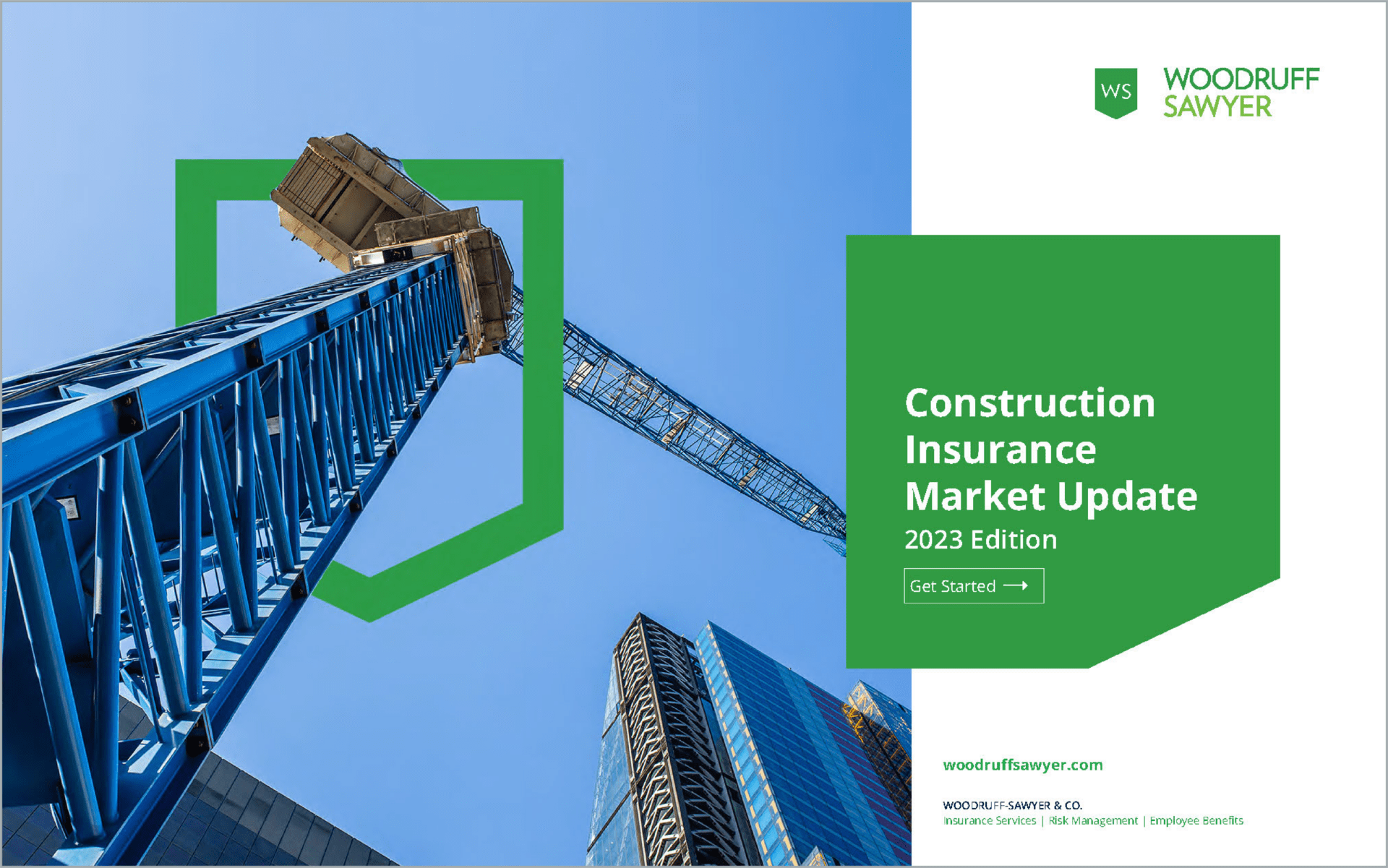Blog
Construction Insurance Market Update: Rate Consistency for Most Lines
Despite a slowing economy and continuing supply chain issues, rates in most lines of coverage for construction companies are showing signs of stabilization. Even cyber, which had some of the highest increases last year, slowed somewhat in the first quarter of 2023.
However, there are some exceptions. The umbrella market continues to provide difficulties in securing affordable lead excess coverage. Meanwhile, the property market experienced an average premium increase of 20% in some coverages, driven by catastrophic claims and inflationary pressure due to supply chain constraints.
Woodruff Sawyer’s Construction Insurance Market Update will help you understand the dynamic nature of the market so you can consider macro market events as well as factors within your control that affect your insurance spend.
The guide includes advice on risk mitigation efforts, claims history, nature of operations, and volume of work to help you navigate the evolving construction insurance market more effectively. Read the overview below and download the full PDF Update.
Workers' Compensation: A Bright Spot for Rate Relief
For the fifth straight quarter, workers' compensation (WC) rates dropped moderately (-0.5%) in the first quarter of 2023. One factor is that the adaptation of technology and automation have contributed to lower injury rates for some contractors. Additionally, those with strong safety fundamentals and adequate claims management are seeing greater year-over-year consistency. However, rising medical costs and the shortage of skilled labor continue to be a concern.
Here are our mitigation strategies:
- Partner with your insurance carrier and broker for continued focus on safety programs.
- Utilize technology for job hazard analysis and pre-task planning to help with efficiency, lower injury rates and create and maintain safer work environments.
- Revisit your return-to-work strategies to help your labor force get back to modified duty in a timely and strategic manner.
General Liability: Flat to 10% Increases
Rates continue to increase for certain general liability segments, but the pace has slowed. Contractors performing residential construction, wildfire prone risks, and some heavy highway exposures continue to encounter the most problems.
Mitigation strategies include:
- Identify the right carrier partners to meet your business needs early in your renewal cycle.
- Offer underwriters as many details as you can about your operations, including how your firm manages safety, quality control, risk transfer and claims processes.
- Ensure your subcontractor risk transfer processes are current and well-documented.
- Provide complete submissions and facilitate live or virtual loss control visits when necessary.
Auto Liability: Loss Trends Continue
Commercial auto markets sought 8–12% rate increases—their highest in the past several quarters—as large verdicts continue to be a cause for concern for carriers. Supply chain disruption and auto part shortages are also leading to increased repair costs, making physical damage coverage unappealing to carriers.
Our strategies for mitigation are:
- Use technology tools (such as telematics) for larger fleets to help manage risk on the road.
- Provide robust driver training and monitor drivers with a history of driving infractions.
- Maintain updated vehicle maintenance programs. Stay awake. Ensure you have good risk mitigation plans to combat fatigue. Longer hours and longer commutes can pose a significant risk to contractors and impact multiple lines of coverage.
Excess Liability: New Entrants Create More Competition
New entrants in the excess insurance markets are providing additional competition and capacity. We saw increases of up to 8.5% in the first quarter. Although underwriter willingness to offer excess limits above $10 million in a single layer is still hard to find, new markets are helping contractors secure needed limits compared to the past three years.
Strategies for mitigation include:
- Secure options for higher primary general liability and auto liability limits or secure a buffer layer to raise your attachment point and attract additional lead excess carriers.
- Use a quota share layering approach to attract more carriers to your account.
- Leverage your primary underwriting relationship and request higher excess limits from your carrier that already supports your WC, commercial auto, and general liability.
- Provide quality information to the marketplace on any large losses that may impact the excess layers.
Property/Inland Marine: Natural Disasters Drive Losses
The fixed property insurance market (i.e., large property portfolio with heavy earthquake, flood, and wildfire exposed risks) continues to see upward rate pressure and increases in building valuations. Increases averaged 20.4% in the first quarter. Contractors with relatively small property portfolios and favorable loss histories can negotiate competitive renewal terms for their property exposures.
Here are mitigation strategies:
- Document your use of tracking devices (GPS) and detail project site and storage yard security measures.
- Carefully monitor employees and subcontractors on large job sites to protect valuable equipment from theft.
- Provide documentation of recent building valuations and building updates and improvements.
- Offer underwriters details on project security measures and risk management plans.
Professional & Pollution Insurance: 5–10% Increases
The pollution market remains steady, with an increase in demand matched by an increase in carriers entering the market. For professional liability, buyers are continuing to see price increases along with increased retentions for most risks. Insurers continue to correct rates and pricing to better align with long-term experience trends, ultimately leading to carriers seeking moderate increases.
For mitigation strategies, consider the following:
- Establish a renewal strategy early.
- Ensure the definition of “professional services” is broadly written and consistent with your operations and includes work performed “by or on your behalf.”
- Understand the importance of disclosing matters that could lead to a potential claim.
- Review renewal exposures against expected exposures and those of prior years.
Directors & Officers Liability and Employment Practices Liability
With a 7.8% average increase in pricing over the first quarter, D&O continues to show moderate price increases and an increase in capacity. We see the potential opportunity to decrease or at least keep retentions flat as the year continues.
Consider the following mitigation strategies:
- Use carrier resources and counsel specializing in employment law to craft your risk management and human resource procedures.
- Conduct an enterprise approach to bridge the gap between HR, safety, finance, and operations.
Cyber: Some Noticeable Softening
After an average premium increase of 27.5% in 2022, cyber premiums softened in the first quarter of 2023 with an average increase of 8.4%. Risk management controls such as an adaptation of multi-factor authentication (MFA) have allowed new carriers to enter the market, increasing competition. At the same time, however, there is an increased risk of ransomware attacks, a growing digital workforce, and an increasingly unfriendly regulatory environment.
Here are our mitigation strategies:
- Invest time and resources in IT security controls and policies.
- Outline vendor management controls if you rely heavily on third-party vendors for any key IT and security services.
- Take advantage of training your insurer may offer.
We strongly recommend speaking with your broker early in the renewal process to establish a clear marketing strategy, develop a renewal budget, secure adequate underwriting details, and, where necessary, schedule carrier meetings with leadership to best tell your story. A proactive and transparent approach will help avoid surprises and secure the most favorable program terms in this evolving market.
For more details on these markets, read the Construction Insurance Market Update, 2023 Edition below.
Authors
Table of Contents

















